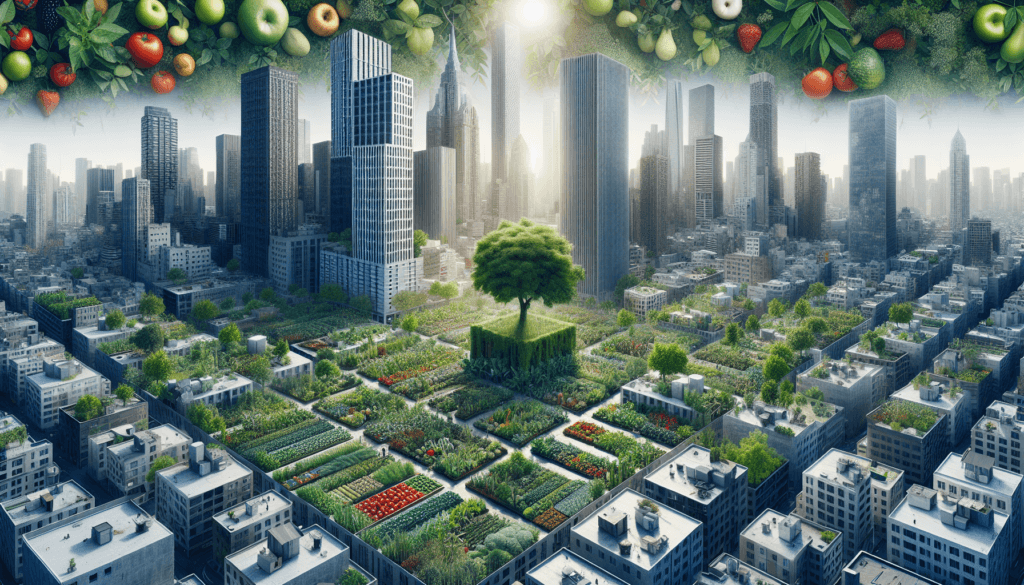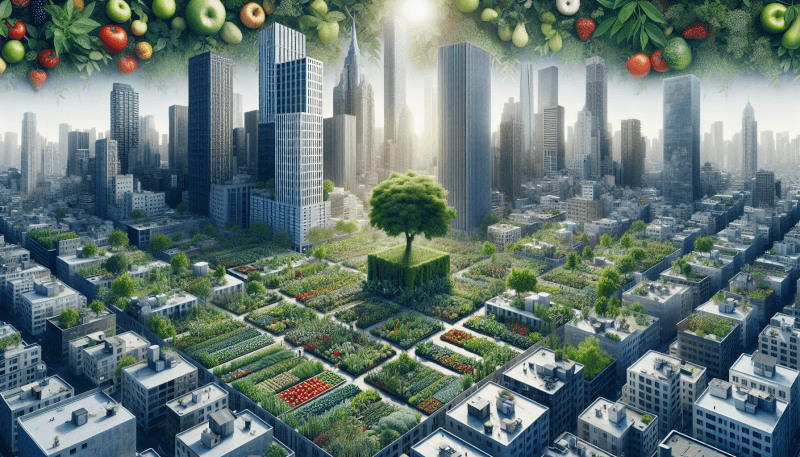Urban gardens are playing an increasingly vital role in mitigating climate change by providing a space for community engagement and sustainable practices. These growing pockets of green within our cities not only bring beauty to concrete landscapes but also contribute to reducing CO2 emissions, improving air quality, conserving water, and fostering biodiversity. Through their innovative practices, urban gardens offer a practical and accessible solution to combat the effects of climate change while reaping the benefits of locally sourced, organic produce. Discover how these vibrant urban oases are making a significant impact on our environment and working towards a greener, more sustainable future.

1. Urban Gardens and Climate Change
1.1 Understanding Climate Change
Climate change refers to the long-term changes in temperature, precipitation patterns, and weather conditions that are occurring on a global scale. These changes are primarily driven by human activities, such as the burning of fossil fuels and deforestation, which release large amounts of greenhouse gases into the atmosphere. The accumulation of these gases, such as carbon dioxide (CO2), methane (CH4), and nitrous oxide (N2O), traps heat from the sun and leads to a rise in global temperatures. As a result, we are experiencing more frequent and intense heatwaves, droughts, floods, and other extreme weather events.
1.2 The Importance of Mitigating Climate Change
Mitigating climate change is crucial for the well-being of our planet and future generations. The increasing concentration of greenhouse gases in the atmosphere is causing significant disruptions to ecosystems, threatening biodiversity, and exacerbating social and economic inequalities. To prevent catastrophic impacts, we must take immediate action to reduce our greenhouse gas emissions and transition to a more sustainable and low-carbon economy. This requires a collective effort from individuals, communities, businesses, and governments to adopt climate-friendly practices and technologies.
1.3 Introduction to Urban Gardens
Urban gardens, also known as community gardens or rooftop gardens, are spaces within urban areas that are dedicated to growing plants, herbs, fruits, and vegetables. These gardens can be found in various forms, including backyard gardens, public parks, and even vertical gardens on the sides of buildings. Urban gardening has gained popularity in recent years as a way to reconnect with nature, promote sustainable living, and enhance the resilience of urban communities. It provides opportunities for individuals to grow their own food, improve the local environment, and engage in communal activities.
2. Urban Gardens as Carbon Sinks
2.1 Definition of Carbon Sinks
A carbon sink is any natural or artificial reservoir that absorbs more carbon dioxide from the atmosphere than it releases. Carbon sinks play a critical role in mitigating climate change by removing CO2, the primary greenhouse gas, from the atmosphere and storing it for extended periods. Forests and oceans are two major examples of natural carbon sinks. However, urban gardens can also act as effective carbon sinks, especially when designed to maximize plant growth and carbon sequestration.
2.2 Carbon Sequestration in Urban Gardens
Carbon sequestration refers to the process of capturing and storing carbon dioxide from the atmosphere. Urban gardens can sequester carbon through photosynthesis, the biological process by which plants convert CO2 into oxygen and organic matter. As urban gardens typically have a high density of vegetation, they can absorb substantial amounts of carbon dioxide. Additionally, the incorporation of organic matter, such as compost or mulch, into the soil can further enhance carbon sequestration by increasing soil organic carbon content.
2.3 Examples of Urban Gardens as Carbon Sinks
Numerous urban gardens around the world have demonstrated their potential as carbon sinks. One notable example is the High Line in New York City, a public park built on an elevated railway track. The park features an extensive green roof with diverse plant species, which helps to absorb carbon dioxide and reduce the heat island effect in the surrounding area. Another example is the Singapore Changi Airport, which has incorporated green walls and rooftop gardens into its design. These green spaces not only beautify the airport but also contribute to carbon sequestration and energy efficiency.
3. Urban Gardens and Biodiversity Conservation
3.1 Enhancing Biodiversity in Urban Areas
Urbanization has significant impacts on biodiversity, as it often leads to the destruction and fragmentation of natural habitats. However, urban gardens can help to mitigate these effects by providing new habitats and resources for a wide range of plant and animal species. By creating diverse and ecologically-friendly garden designs, we can attract pollinators, birds, and other wildlife and contribute to the conservation of urban biodiversity.
3.2 Role of Urban Gardens in Supporting Wildlife
Urban gardens offer food, shelter, and breeding opportunities for various wildlife species. By planting native plants and incorporating diverse vegetation, we can attract pollinators such as bees, butterflies, and birds, which play a crucial role in the reproduction of many plant species. Additionally, urban gardens can act as stepping stones or corridors for wildlife movement, connecting fragmented habitats and promoting genetic diversity.
3.3 Creating Urban Habitats through Gardens
Urban gardens can act as important habitats for both native and non-native species. By selecting a variety of plants that provide food, shelter, and nesting spaces, we can create welcoming environments for insects, birds, and small mammals. Additionally, the inclusion of water features, such as ponds or bird baths, can further enhance the habitat value of urban gardens by attracting amphibians, reptiles, and aquatic insects.
4. Urban Gardens and Food Security
4.1 Growing Food Locally
One of the significant benefits of urban gardens is their ability to contribute to local food production and improve food security. By growing fruits, vegetables, and herbs within the city limits, urban gardens reduce the reliance on long-distance transportation and increase access to fresh, nutritious, and locally-grown produce. This is especially important in urban areas where access to healthy food options may be limited, leading to food deserts and health disparities.
4.2 Reducing Food Miles and Emissions
The concept of food miles refers to the distance that food travels from where it is produced to where it is consumed. Long-distance transportation of food contributes to greenhouse gas emissions, as it requires fossil fuels for fueling trucks, ships, and planes. However, urban gardens significantly reduce food miles by producing food right where it is consumed. This not only cuts down on emissions but also reduces the pressure on agricultural land and supports more sustainable farming practices.
4.3 Promoting Sustainable Agriculture
Urban gardens play a crucial role in promoting sustainable agriculture practices. By using organic farming techniques, such as composting, crop rotation, and natural pest control, urban gardeners can minimize the use of synthetic fertilizers and pesticides, which can harm human health and the environment. Additionally, the cultivation of diverse crops in urban gardens helps to enhance soil fertility, reduce soil erosion, and protect against pests and diseases.

5. Urban Gardens and Sustainable Water Management
5.1 Rainwater Harvesting in Urban Gardens
Urban gardens can contribute to sustainable water management through the adoption of rainwater harvesting techniques. By collecting and storing rainwater, gardeners can reduce their reliance on municipal water sources and conserve resources. Rain barrels or cisterns can be used to capture rainwater from rooftops, which can then be used for irrigation purposes. This practice not only reduces water consumption but also prevents stormwater runoff, which can contribute to water pollution and flooding.
5.2 Reducing Stormwater Runoff
Urban gardens have the potential to mitigate the negative impacts of stormwater runoff, which occurs when rainwater flows over paved surfaces and collects pollutants before entering water bodies. By incorporating permeable surfaces, such as porous pavement or gravel, into garden designs, we can allow rainwater to infiltrate into the soil instead of becoming runoff. This helps to replenish groundwater supplies, reduce soil erosion, and minimize the pollution of rivers, lakes, and oceans.
5.3 Managing Water Consumption
In addition to rainwater harvesting, urban gardens can reduce water consumption through efficient irrigation practices. Drip irrigation systems, which deliver water directly to the plant roots, are highly efficient and minimize water loss through evaporation or runoff. Moreover, the use of mulch, such as straw or wood chips, helps to retain soil moisture and reduce the need for frequent watering. By implementing these water-saving strategies, urban gardeners can contribute to water conservation efforts and ensure the sustainable use of this precious resource.
6. Urban Gardens and Air Quality Improvement
6.1 Plants as Natural Air Filters
Plants have the remarkable ability to improve air quality by acting as natural air filters. Through the process of photosynthesis, plants absorb carbon dioxide and release oxygen, helping to reduce greenhouse gas concentrations. Additionally, plants can remove various air pollutants, such as nitrogen dioxide, ozone, and volatile organic compounds (VOCs), through a process known as phytoremediation. This makes urban gardens valuable in mitigating air pollution and creating healthier living environments.
6.2 Reducing Air Pollution in Urban Areas
Urban areas are often plagued by high levels of air pollution, which can have detrimental effects on human health. However, urban gardens can help to reduce air pollution by capturing airborne pollutants and improving air circulation. The dense vegetation in urban gardens acts as a physical barrier that traps particulate matter, absorbs pollutants, and reduces the dispersion of pollutants into the atmosphere. This helps to create cleaner and healthier air for both humans and wildlife.
6.3 Mitigating Urban Heat Island Effect
Urban gardens play a vital role in mitigating the urban heat island effect, which refers to the phenomenon where cities are significantly warmer than surrounding rural areas due to human activities and the lack of vegetation. The shade provided by trees and plants in urban gardens helps to lower air temperatures, reduce energy consumption for cooling buildings, and improve human comfort. Additionally, the evapotranspiration process, in which plants release moisture into the air, cools the surrounding environment and helps to offset the heat generated by urban infrastructure.

7. Urban Gardens and Community Engagement
7.1 Social Benefits of Urban Gardens
Urban gardens offer numerous social benefits that contribute to community well-being and cohesion. By providing spaces for people to come together, engage in gardening activities, and connect with nature, urban gardens foster a sense of belonging and strengthen social relationships. These spaces provide opportunities for intergenerational interactions, cultural exchange, and the sharing of knowledge and skills. Additionally, urban gardens can improve mental health and well-being by providing a peaceful and therapeutic environment for individuals to relax, destress, and reconnect with themselves and the natural world.
7.2 Promoting Education and Awareness
Urban gardens serve as valuable educational resources, especially in urban areas where access to nature may be limited. They provide hands-on learning opportunities for children and adults to develop gardening skills, learn about plant biology, and understand the importance of sustainable practices. Furthermore, urban gardens can raise awareness about environmental issues, such as climate change, biodiversity loss, and food insecurity, and inspire individuals to take action for a more sustainable future. Through workshops, educational programs, and community events, urban gardens empower individuals to become environmental stewards and advocates for positive change.
7.3 Empowering Communities
Urban gardens empower communities by providing spaces for self-sufficiency, creativity, and empowerment. By growing their own food, urban gardeners gain control over their food sources and reduce their dependence on the industrialized food system. This fosters a sense of empowerment and resilience, especially in marginalized communities that may face food insecurity or limited access to healthy options. Additionally, urban gardens can serve as platforms for community-led initiatives, entrepreneurship, and social enterprises, enabling individuals to develop new skills, generate income, and strengthen economic resilience.
8. Urban Gardens and Green Infrastructure
8.1 Integration with Urban Planning
The integration of urban gardens into urban planning processes is essential for maximizing their benefits and ensuring their long-term sustainability. Urban planners should consider incorporating green spaces and urban gardens into city designs, ensuring equitable access for all residents. This integration can help to improve the quality of life, enhance the aesthetics of urban areas, and mitigate the adverse effects of urbanization. By adopting a holistic approach to urban development, we can create more sustainable and resilient cities that prioritize the well-being of both people and the environment.
8.2 Role of Urban Gardens in Green Spaces
Urban gardens contribute to the creation of green spaces within cities, which are crucial for maintaining ecological balance, supporting biodiversity, and enhancing the urban environment. These green spaces provide important ecosystem services, such as air purification, temperature regulation, and noise reduction. Moreover, urban gardens can serve as recreational areas, offering opportunities for relaxation, exercise, and community gatherings. By integrating urban gardens into green spaces, we can create vibrant and livable cities that prioritize the health and well-being of their residents.
8.3 Enhancing Urban Aesthetics
Urban gardens have the capacity to enhance the aesthetics of urban areas by adding beauty, color, and texture to the built environment. Through thoughtful design and landscaping, urban gardens can transform vacant lots, rooftops, or neglected spaces into thriving and inviting landscapes. The incorporation of diverse plant species, vertical gardens, or rooftop gardens can create visually appealing and inspiring urban environments. Furthermore, urban gardens can serve as showcases for innovative and sustainable design practices, inspiring others to incorporate green features into their own spaces.

9. Urban Gardens and Climate Resilience
9.1 Adapting to Climate Change Impacts
Climate change is already impacting cities around the world, exposing them to increased risks of flooding, heatwaves, and other extreme weather events. Urban gardens can play a crucial role in building climate resilience by providing adaptable and resilient spaces. By implementing climate-smart practices, such as water-wise gardening, heat-tolerant plant selection, and stormwater management strategies, urban gardens can minimize their vulnerability to climate change impacts. Additionally, the diversity of plant species in urban gardens increases resilience to pests, diseases, and changing climatic conditions.
9.2 Urban Gardens as Resilient Spaces
Urban gardens are inherently resilient spaces that can withstand and recover from disturbances. Through the incorporation of resilient plant species, soil conservation practices, and adaptive management strategies, urban gardens can bounce back from extreme weather events or other disruptions. Furthermore, the social networks and community support systems that often emerge around urban gardens contribute to their resilience by fostering cooperation, information sharing, and collective action.
9.3 Strengthening Community Resilience
Urban gardens have the potential to strengthen community resilience by providing spaces for social cohesion, food security, and emergency preparedness. In times of crisis, such as natural disasters or economic challenges, urban gardens can serve as community food sources, ensuring access to fresh produce and reducing reliance on external supply chains. Additionally, the shared experiences and knowledge exchange that occur in urban gardens can foster a sense of community resilience, enabling individuals and neighborhoods to navigate challenges together and recover more quickly.
10. Policy and Planning Considerations for Urban Gardens
10.1 Incorporating Urban Gardens in Policies
To fully harness the potential of urban gardens, it is crucial for governments and city planners to incorporate them into policies and land-use plans. This involves recognizing the multiple benefits of urban gardens and providing incentives, guidelines, and support mechanisms for their establishment and maintenance. By integrating urban garden provisions into zoning and development regulations, governments can ensure that urban gardens have adequate space, resources, and legal protection. Additionally, financial incentives, tax breaks, and grants can encourage individuals and communities to engage in urban gardening activities.
10.2 Encouraging Public and Private Partnerships
Public and private partnerships play a vital role in the development and sustainability of urban gardens. Governments, non-profit organizations, businesses, and community groups can collaborate to provide funding, technical support, and shared resources for urban gardening initiatives. These partnerships can facilitate knowledge transfer, capacity building, and the scaling up of successful urban gardening models. By leveraging the strengths and resources of different stakeholders, we can create a supportive ecosystem for urban gardens and ensure their long-term viability.
10.3 Ensuring Equitable Access to Urban Gardens
Equitable access to urban gardens is crucial for achieving social, economic, and environmental justice. Governments and organizations should strive to ensure that urban gardens are accessible to all residents, regardless of their socioeconomic status, race, or geographical location. This can be done through the establishment of community gardens in underserved neighborhoods, the provision of resources and support to disadvantaged communities, and the promotion of inclusive and participatory decision-making processes. By prioritizing equity in urban gardening initiatives, we can create a more just and sustainable society for all.



